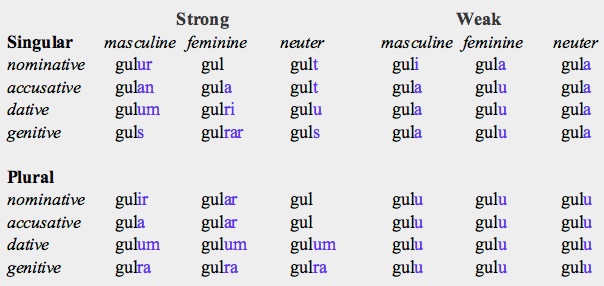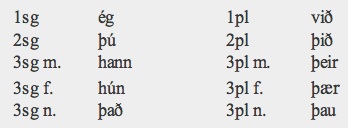An insatiable appetite for ancient and modern tongues


Classification: Indo-European, Germanic, North Germanic. The other languages in this branch are Swedish, Norwegian, Danish and Faroese.
Overview. Icelandic developed from Norse speech brought into Iceland from western Norway in the 9th-10th centuries. Old Icelandic and Old Norse are virtually the same because almost all of the ancient literature that has survived was composed in Iceland in the Middle Ages. It includes the Eddas, numerous sagas and skaldic poems. By this time, Icelandic began to differentiate itself from Norwegian. Modern Icelandic is the most conservative of the Scandinavian languages and it is most closely related to the southwestern dialects of Norway and to Faroese.
Distribution. 95 % of all Icelandic speakers live in Iceland; smaller numbers reside in Denmark and North America.
Speakers. About 336,000, of which 320,000 in Iceland, 8,200 in Denmark, 5,700 in USA, and 2,400 in Canada.
Status: it is the national language of Iceland.
Varieties. Dialectal variations are minimal and for this reason there has been no need to define a standard language.
Periods
800-1540 CE. Old Icelandic is a synonym of Old Norse because the vast majority of surviving texts in this language are from Iceland.
1540 CE -present. Modern Icelandic. Begins with the publication of the first Icelandic translation of the Bible.
Phonology
Vowels. Icelandic has eight simple vowels and five diphthongs.
-
a) Monophthongs (8): modern Icelandic has eight basic vowels exhibiting a contrast between roundedness and unroundedness. Their symbols in the International Phonetic Alphabet are shown first, and between brackets their equivalence in the Icelandic alphabet.

-
b) Diphthongs (5): ei (ei, ey), œi (au), ai (æ), ou (ó), au (á).
Consonants (30). Modern Icelandic has four pair of stops contrasting between unaspirated and aspirated. It also has pairs of contrasting nasals and liquids but their contrast is between voiceless and voiced. In fact, the occurrence of voiceless nasals and liquids is quite unusual among the languages of the world. Icelandic is also noteworthy for having developed preaspirated stops (not shown in the table) which may be contrastive e.g. frekna [frɛʰkna] ‘freckle’ and fregna [frɛkna] ‘to be informed’.

Note: this table is not strictly phonemic as the contrast between voiceless and voiced nasals and liquids is minimal is some positions.
Stress: mayor stress falls on the first syllable.
Script and Orthography
Icelandic is written in a Latin-derived alphabet containing 32 letters. Their equivalence in the International Phonetic Alphabet is shown between brackets.

Another 3 letters (c, q, w) are used only in foreign words while z is used for foreign words and in archaic Icelandic spelling.
-
•[ç] is represented by the digraph hj.
-
•[ɲ̊] and [ɲ] are represented by the digraph nj.
-
•[ŋ̊] and [ŋ] are represented by the digraph ng.
Morphology
-
Nominal
-
•gender: masculine, feminine, neuter. Noun gender is evidenced through the definite article as well as by adjective and pronominal agreement.
-
•number: singular, plural. Plural formation is linked to case declension (see below).
-
•case: nominative, accusative, dative, genitive.
-
Nouns are 'strong' or 'weak' and have different paradigms for each gender. Masculine weak nouns end in i in the nominative singular; feminine and neuter ones end in a or i.

-
•adjectives: have 'strong' and 'weak' declensions. The strong form is employed when the adjectives qualify an indefinite noun or when they are used predicatively; the weak form when they modify a definite noun. For example, the declension of the adjective gulur ('yellow') is:

-
Comparison is made with the infix -ar- and the superlative with the infix -ast-/-ust-. Indeclinable adjectives can form comparatives and superlatives with meira ('more') and mest ('most').
-

-
•articles: there is no indefinite article but there is a definite one that is inflected like an adjective. It may be free or suffixed to the noun. The free article is used when the noun is preceded by an adjective:
-
The suffixed article derives from the free form by dropping h(i). For example: the nominative singular of the masculine noun 'horse' is hestur-inn ('the horse'), and its nominative plural hestar-nir ('the horses').
-
•pronouns: personal, possessive, demonstrative, interrogative, indefinite.

-
Personal pronouns: first and second person pronouns are not marked for gender but the third person distinguishes masculine, feminine, and neuter. They decline in the four cases and their declension is quite irregular. There is a reflexive form for the third person which has no nominative and is the same for singular and plural (accusative sig, dative sér, genitive sín). The nominative of the personal pronouns is shown above.
-
Possessive pronouns exist for the 1st and 2nd persons but for the 3rd person the genitive forms of the personal pronouns are used. Besides, there is an invariable reflexive possessive pronoun (sinn) meaning: his/her/its/their.
-
Demonstrative pronouns distinguish proximal (ϸessi [m/f], ϸetta [n]) and distal (sá [masc], sú [fem], pað [neuter]). They have plural forms and are declined in four cases.
-
The interrogative pronouns are hver (‘who?’) and hvað (‘what?’).
-
There are no relative pronouns, the relative particles sem and er are employed, instead; the latter restricted to the written language.
-
•compounds: are commonplace and most of them are formed by two nouns although adjective + noun compounds are also frequent. Only the last word of the compound is inflected.
-
Verbal
-
•person and number: 1s, 2s, 3s; 1p, 2p, 3p.
-
•mood: indicative, subjunctive, imperative (only for 2nd person singular).
-
•aspect: perfective, imperfective, aoristic.
-
The perfective is represented by the perfect tenses, the imperfective by the progressive (an ongoing action) and the inchoative (an action that is about to start), the aoristic by the simple past and the simple future.
-
•tense: present, progressive, inchoative, past, perfect, pluperfect, future, future perfect, conditional present, conditional past.
-
The present and past are the only tenses formed without an auxiliary verb. Weak verbs form the past tense by adding a dental suffix to the stem. Strong verbs do not have a particular suffix for the past but, instead, exhibit a vowel change in the stem (ablaut). Other, compound, tenses require auxiliaries.
-
The perfect and pluperfect are formed, respectively, with the present and past of hafa (‘have’) + the neuter past participle (called supine). The future and conditional use, respectively, the present and past of the auxiliary munu (‘will’). In the simple future and present conditional combined with the infinitive; in the future perfect and past conditional combined with the infinitive of hafa + the past participle.
-
The progressive requires vera (‘be’) + að (‘to’) + infinitive, and the inchoative fara (‘go’) + að (‘to’) + infinitive.
-
For example, the 1st person singular of the weak verb telja (‘to believe’) in several tenses and moods is:

-
The non-finite forms are:
-
infinitive: telja
-
past participle: talinn
-
supine: talið
-
present participle: teljandi
-
There are four weak conjugations and six strong ones:

-
•voice: active, middle, passive. The passive is made with the auxiliary vera (‘be’) + the past participle. The so-called "middle voice" has a variety of functions; it is formed by adding the suffix -st to the verb inflected in the active voice.
-
•non-finite forms: infinitive, present participle, past participle and supine. The latter is formally identical to the neuter form of the past participle.
Syntax
The neutral word order is Subject-Verb-Object (SVO). In yes/no questions the finite verb takes the first place in the sentence followed by the subject (VSO). In imperative sentences the verb comes first, as well. Icelandic is, like other Germanic languages, a verb second (V2) language: the finite verb obligatorily occurs no later than in the second position in all main clauses. Thus, if something is topicalized the subject will follow the verb rather than precede it. Negation follows the verb.
Pronouns, numerals and adjectives precede their nouns (in this order) agreeing with them in gender, number and case. Relative clauses follow their heads. Demonstrative pronouns and the definite article trigger the weak inflection of adjectives. Genitives of nouns normally follow their head.
Lexicon
There are comparatively few loanwords in Icelandic. Early loans are from Celtic, Latin, French and German; more recent loans tend to be from Danish and English.
Basic Vocabulary
Numerals 1-4 are declined for gender and case (here only the nominatives are shown).
one: einn (m), ein (f), eitt (n)
two: tveir (m), tvær (f), tvö (n)
three: þrír (m), þrjár (f), þrjú (n)
four: fjórir (m), fjórar (f), fjögur (n)
five: fimm
six: sex
seven: sjö
eight: átta
nine: níu
ten: tíu
hundred: hundrað
father: faðir
mother: móðir
brother: bróðir
sister: systir
son: sonur
daughter: dóttir
head: höfuð
face: andlit
eye: auga
hand: hönd
foot: fótur
heart: hjarta
tongue: tunga
Key Literary Works (forthcoming)
-
© 2013 Alejandro Gutman and Beatriz Avanzati
Further Reading
-'Icelandic'. H. Thráinsson. In The Germanic Languages, 142-189. E. König & J. van der Auwera (eds). Routledge (1994).
-Icelandic: grammar, texts, glossary. S. Einarsson. Johns Hopkins University Press (1945).
-The Nordic languages: an international handbook of the history of the North Germanic languages (2 vols.). O. Bandle et al (eds). Mouton de Gruyter (2003-5).
Icelandic

Address comments and questions to: gutman37@yahoo.com
MAIN LANGUAGE FAMILIES
LANGUAGE AREAS
Languages of Ethiopia & Eritrea
LANGUAGES by COUNTRY
LANGUAGE MAPS
-
• America
-
• Asia
-
Countries & Regions
-
-
Families
-
• Europe
-
• Oceania